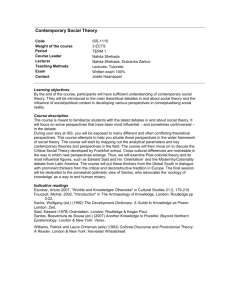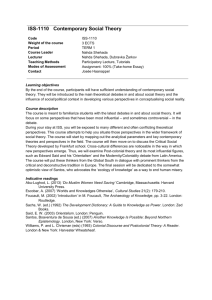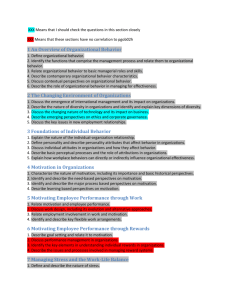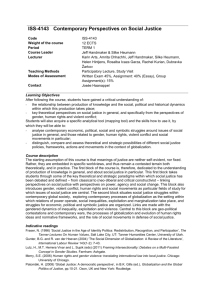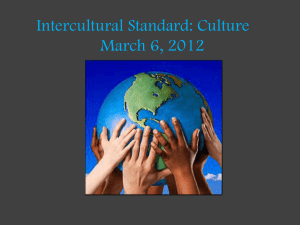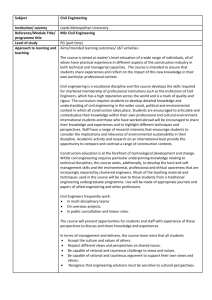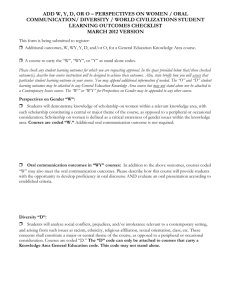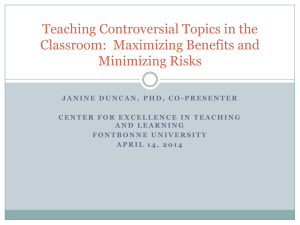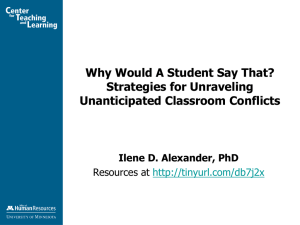Historical Perspectives - Stones: A Guide to the Social History of
advertisement
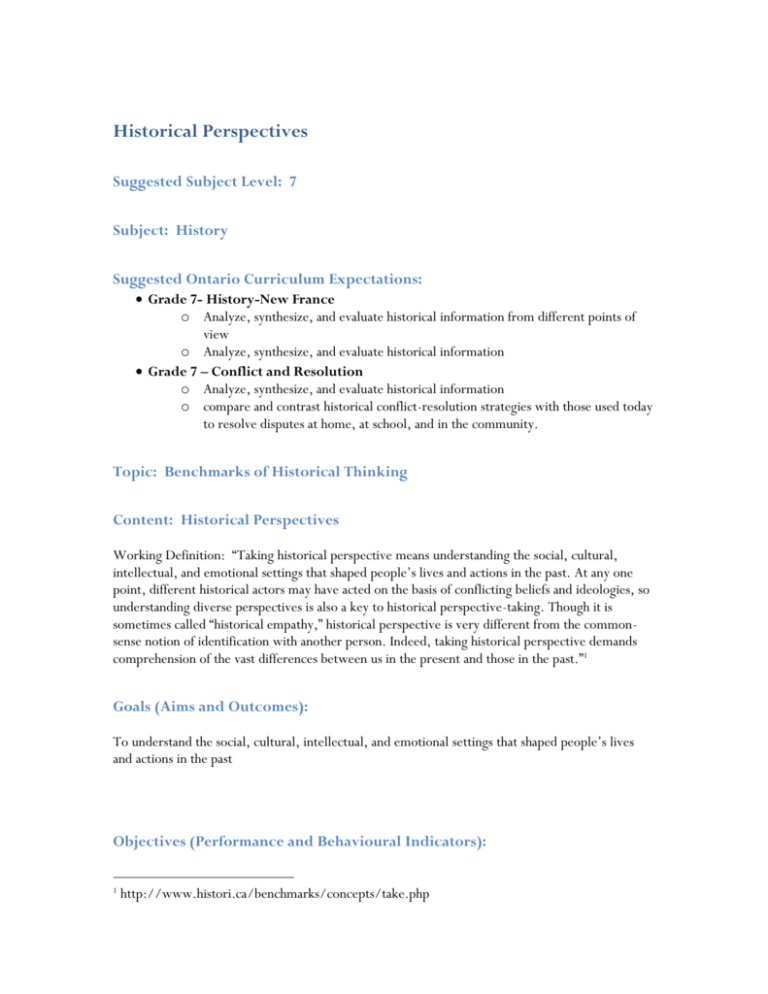
Historical Perspectives Suggested Subject Level: 7 Subject: History Suggested Ontario Curriculum Expectations: Grade 7- History-New France o Analyze, synthesize, and evaluate historical information from different points of view o Analyze, synthesize, and evaluate historical information Grade 7 – Conflict and Resolution o Analyze, synthesize, and evaluate historical information o compare and contrast historical conflict-resolution strategies with those used today to resolve disputes at home, at school, and in the community. Topic: Benchmarks of Historical Thinking Content: Historical Perspectives Working Definition: “Taking historical perspective means understanding the social, cultural, intellectual, and emotional settings that shaped people’s lives and actions in the past. At any one point, different historical actors may have acted on the basis of conflicting beliefs and ideologies, so understanding diverse perspectives is also a key to historical perspective-taking. Though it is sometimes called “historical empathy,” historical perspective is very different from the commonsense notion of identification with another person. Indeed, taking historical perspective demands comprehension of the vast differences between us in the present and those in the past.”1 Goals (Aims and Outcomes): To understand the social, cultural, intellectual, and emotional settings that shaped people’s lives and actions in the past Objectives (Performance and Behavioural Indicators): 1 http://www.histori.ca/benchmarks/concepts/take.php Students will be expected to: Understand the “past as a foreign country,” with its different social, cultural, intellectual and even emotional contexts that shaped people’s lives and actions; Recognize presentism in historical accounts; Use evidence and understanding of the historical context, to answer questions about why people acted as they did (or thought as they did) even when their actions seem at first irrational or inexplicable or different from what we would have done or thought.2 Materials (Aids/AV/Technology): Computers with Internet Access Introductory Activity (Focusing Event): Discussion Questions, whether approached as a whole class or divided amongst smaller groups, can help students focus their thinking on questions related to the assumption of historical perspectives.3 Sample questions follow: a. Take something from a student (e.g., a pencil, a food item, a coat); claim it as your own: is this a legitimate claim? Then list, with students, the various bases for ownership (historical possession, mutual agreements for an exchange, standard practices of exchange b. What rights do you and your family have in relation to your home and your subsistence (having adequate clean, safe water, food and shelter c. Where did these rights come from? Who protects these rights? Who will protect these rights in the future? [hopefully this discussion will end up with the understanding that history is important: that rights are secured in part through claims about what happened in the past: a rental agreement was signed, a property was bought and these carried forward into the future on the basis of trust between parties and the state which could enforce that trust. Development Activity (Modeling/Explanation/Demonstration): Begin to explore the concept of “colonization” with the students and list, as a whole class or in smaller groups, potential reasons why various countries (i.e. France, England, Holland, Spain, etc.) throughout history colonized other lands. Focusing and leading questions could include: “Is this acceptable today? Why or why not?“ Ask students to explain it from the perspective of the colonizers and from the perspective of the colonized communities Christina Lanteigne, Colin Cameron: http://www.histori.ca/benchmarks/tasks/view.php?taskId=71 3 Peter Seixas, Liz Krieg: http://www.histori.ca/benchmarks/tasks/view.php?taskId=35 2 Follow-up Activity: Students can be asked to form groups and represent the concept of contemporary globalization and relate it to discussion on colonization. Drama or art can be used as media for the presentation. Practice (Guided/Monitored Activity): Students can be asked to find examples in their own schooling (history or social studies education) where particular historical perspectives and aspects were overlooked. Focusing and leading questions could include: “We discussed the role of European explorers in the early colonization of New France, but not why many of those explorers were white, Christian men.” Independent Practice (Relation to STONES social history research): Students can be asked to read the text on Jewish Community in Kingston.4 Take the tour online or, if possible, in person. A class trip to the sites might be possible. A model rubric, to be modified by the teacher, is included in the folder, titled: “Historical Perspective Taking Rubric.” Students should be asked to jot down, as they emerge, thoughts or feelings provoked by the tour text or sites. They can attempt to consider the context empathetically. How do these experiences relate to the present world and contemporary problems in society? Students can, independently, write a letter to a municipal, provincial, or federal representative, or a government agency, relating a contemporary concern raised by the study of Kingston’s Jewish community. They should defend/support their position on a contemporary problem or concern by citing historical evidence. Accommodations (Differentiated Instruction) Extra time can be afforded to students. Letters can be written electronically, using the supports inherent in many word processing programs (thesaurus, spell check, grammar). 4 Downloaded, or viewed online, at http://stoneskingston.ca/ Checking for Ongoing Understanding (Formative Assessment/Feedback Opportunities) Students can journal, following each activity within the units of study, a reflective entry considering their ongoing understanding of the benchmark for historical thinking, as well as its implications for active, participatory citizenship in contemporary contexts. Teachers can take the opportunity to read these journals and adjust the lessons / course of study to the pace, concerns, and questions raised in the entries. Student and teacher journals can be shared in online space using a blogging tool such as blogger.com Closure (Wrapping up Activities): From the library or storage in the school, old textbooks can be collected and brought to class. Students can examine the topics and historical perspectives conveyed within the texts and compare them with more recent books. The teacher can anticipate any topics or perspectives not covered in previous or recent texts, and provide leading questions to guide the students towards ways of understanding and explaining reasons for which particular views are present at the expense of others.
